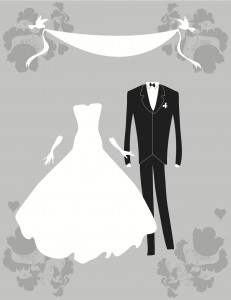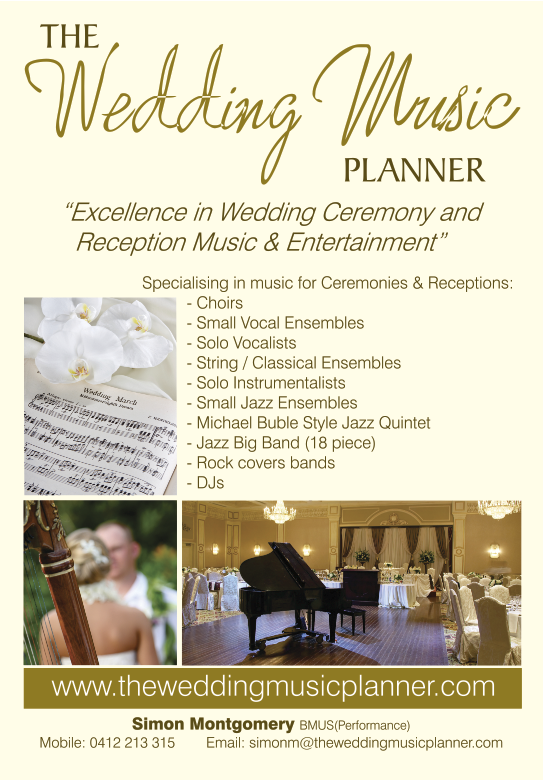With every ruffle, bow, truss, and crease, couples want to look their best on wedding day. To this end, brides and grooms must ensure that their wedding-day attire is properly fitted for maximum comfort and flexibility. Of course, this is not without good reason. With all the standing, sitting, dancing, hugging, eating, crying, and laughter, your wedding-day workout can wreak havoc on your threads. The following tips will help your formalwear meet wedding-day demands.
Tips for the Bride
Because all eyes will be fixed on you, brides carry an extra burden when choosing the perfect wedding gown. Therefore, a bride should:
- Know her body shape. You will need to know this before you begin shopping. There are four main categories of shape including the pear, hourglass, inverted triangle, and rectangle. True enough, there is a considerable amount of variation within these categories. For example, you can be a very petite hourglass or a heavier pear. To determine your shape, stand facing a full-length mirror and draw an imaginary line from the widest point on your shoulders to the widest point of your hips. Now, look at the definition in your waist. How far from your imaginary line is the narrowest part of your waist? Once you have done this, your shape will be determined as follows:
- Pear – your hips are wider than your shoulders, with a very defined waist.
- Hourglass – your hips and shoulders are the same width, with a very defined waist.
- Inverted Triangle – your shoulders are wider than your hips.
- Rectangle – yours shoulders and hips are the same width.
 Review style guides and consult with stylists and sales personnel to determine the type of gown that is best suited for your body shape and measurements.
Review style guides and consult with stylists and sales personnel to determine the type of gown that is best suited for your body shape and measurements.
- Do her homework. Based on your preferences and body type, you will need to have an idea of what you are looking for before you embark on your mission. Do some online research and preview bridal magazines to identify the type and cost of a particular gown style.
- Stay within budget. Avoid trying on gowns without having knowledge of the price tag. You don’t want to fall in love with a gown only to find out that it is entirely out of your price range. Further, do not rule out a lesser priced, vintage, or second-hand wedding dress, and if your budget is nonexistent, you may wish to consider a gown rental.
- Use common sense. Do not purchase a gown based on a dress size that you believe you can achieve before your wedding date. It is easier to have a larger size tailored to fit a shrinking waist or bust line than making adjustments for weight gain. You will also want to shop around and compare pricing. Bridal boutiques are notorious for high-pressure sales tactics. Give yourself plenty of time so that your final decision is not made in haste.
 Tips for the Groom
Tips for the Groom
Now that your bride looks stunning, it is the grooms turn to transform into the most dapper and debonair gentleman he can be. His attire is just as essential as the bride’s gown. Therefore, a groom should:
- Know his measurements. Proper fit is absolutely imperative. Have a professional measure your shoulders, neck, chest, arms, and inseam. Most tailors will provide this service free of charge. Male body types fall within four basic categories including average build, slender, portly, and athletic. As with women, there are countless variations for height and weight. Grooms who are tall and slender have the advantage of looking great in just about any tuxedo style. Regardless of your body type, your suit jacket should fit well, be the proper length, afford you with a full range of motion (whether buttoned or unbuttoned), and allow your shirtsleeves to extend beyond the coat sleeve. Your shirt collar and tie should also complement your build and take into account the thickness of your neck. In addition, the waistline of your trousers should fit properly (not too tight or loose), and the pant leg should break at the top of your shoe and angle downward at the back.
 Understand tuxedo alternatives. There is no mandate that your wedding attire consist of the traditional tuxedo and shoes. You will want to consider the wedding venue when making your final decision. Oftentimes, a tuxedo will appear out of place in a beach-themed or garden wedding. On the other hand, you don’t want to be too casual either. When thinking outside the box, know that an ascot can be worn in lieu of a traditional tie or bowtie, a traditional suit is acceptable, and a vest and cummerbund are optional. Further, although black is the standard, a groom’s formal wedding attire can be off black, gray, navy blue, chocolate brown, or even beige. Choose your colors wisely, and remember to consider the brides attire as well as the wedding theme and color scheme.
Understand tuxedo alternatives. There is no mandate that your wedding attire consist of the traditional tuxedo and shoes. You will want to consider the wedding venue when making your final decision. Oftentimes, a tuxedo will appear out of place in a beach-themed or garden wedding. On the other hand, you don’t want to be too casual either. When thinking outside the box, know that an ascot can be worn in lieu of a traditional tie or bowtie, a traditional suit is acceptable, and a vest and cummerbund are optional. Further, although black is the standard, a groom’s formal wedding attire can be off black, gray, navy blue, chocolate brown, or even beige. Choose your colors wisely, and remember to consider the brides attire as well as the wedding theme and color scheme.
- Consider the Bride’s style. The groom’s attire should always compliment the bride in both style and color. Competing fashions can be distracting, not to mention the photographic evidence of a bad choice. You want to be remembered for all of the right reasons.
- Stay within budget. Although groom attire is less expensive than bridal wear, you will still want to comparison shop. As with the bride’s attire, if your budget is strained or virtually nonexistent, don’t rule out the stress-relieving convenience of a rental.
Lastly, give yourselves plenty of time to allow for alterations and delivery.
Happy Wedding Planning!




